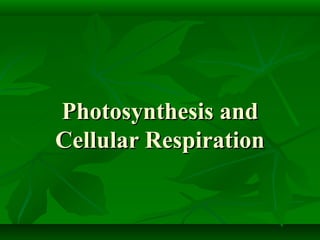
Photosynthesis and Cellular Respiration
- 1. Photosynthesis andPhotosynthesis and Cellular RespirationCellular Respiration
- 2. Outline I. Photosynthesis A. Introduction B. Reactions II. Cellular Respiration A. Introduction B. Reactions
- 3. Photosynthesis Method of converting sun energy into chemical energy usable by cells Autotrophs: self feeders, organisms capable of making their own food – Photoautotrophs: use sun energy e.g. plants photosynthesis-makes organic compounds (glucose) from light – Chemoautotrophs: use chemical energy e.g. bacteria that use sulfide or methane chemosynthesis-makes organic compounds from chemical energy contained in sulfide or methane
- 4. Photosynthesis Photosynthesis takes place in specialized structures inside plant cells called chloroplasts – Light absorbing pigment molecules e.g. chlorophyll
- 5. Overall Reaction 6CO2 + 12 H2O + light energy → C6H12O6 + 6O2+ 6H2O Carbohydrate made is glucose Water appears on both sides because 12 H2O molecules are required and 6 new H2O molecules are made Water is split as a source of electrons from hydrogen atoms releasing O2 as a byproduct Electrons increase potential energy when moved from water to sugar therefore energy is required
- 6. Light-dependent Reactions Overview: light energy is absorbed by chlorophyll molecules-this light energy excites electrons and boosts them to higher energy levels. They are trapped by electron acceptor molecules that are poised at the start of a neighboring transport system. The electrons “fall” to a lower energy state, releasing energy that is harnessed to make ATP
- 7. Energy Shuttling Recall ATP: cellular energy-nucleotide based molecule with 3 phosphate groups bonded to it, when removing the third phosphate group, lots of energy liberated= superb molecule for shuttling energy around within cells. Other energy shuttles-coenzymes (nucleotide based molecules): move electrons and protons around within the cell NADP+, NADPH NAD+, NADP FAD, FADH2
- 8. Light-dependent Reactions Photosystem: light capturing unit, contains chlorophyll, the light capturing pigment Electron transport system: sequence of electron carrier molecules that shuttle electrons, energy released to make ATP Electrons in chlorophyll must be replaced so that cycle may continue-these electrons come from water molecules, Oxygen is liberated from the light reactions Light reactions yield ATP and NADPH used to fuel the reactions of the Calvin cycle (light independent or dark reactions)
- 11. Calvin Cycle (light independent or “dark” reactions) ATP and NADPH generated in light reactions used to fuel the reactions which take CO2 and break it apart, then reassemble the carbons into glucose. Called carbon fixation: taking carbon from an inorganic molecule (atmospheric CO2) and making an organic molecule out of it (glucose) Simplified version of how carbon and energy enter the food chain
- 13. Harvesting Chemical Energy So we see how energy enters food chains (via autotrophs) we can look at how organisms use that energy to fuel their bodies. Plants and animals both use products of photosynthesis (glucose) for metabolic fuel Heterotrophs: must take in energy from outside sources, cannot make their own e.g. animals When we take in glucose (or other carbs), proteins, and fats-these foods don’t come to us the way our cells can use them
- 14. Cellular Respiration Overview Transformation of chemical energy in food into chemical energy cells can use: ATP These reactions proceed the same way in plants and animals. Process is called cellular respiration Overall Reaction: – C6H12O6 + 6O2 → 6CO2 + 6H2O
- 15. Cellular Respiration Overview Breakdown of glucose begins in the cytoplasm: the liquid matrix inside the cell At this point life diverges into two forms and two pathways – Anaerobic cellular respiration (aka fermentation) – Aerobic cellular respiration
- 16. C.R. Reactions Glycolysis – Series of reactions which break the 6-carbon glucose molecule down into two 3-carbon molecules called pyruvate – Process is an ancient one-all organisms from simple bacteria to humans perform it the same way – Yields 2 ATP molecules for every one glucose molecule broken down – Yields 2 NADH per glucose molecule
- 18. Anaerobic Cellular Respiration Some organisms thrive in environments with little or no oxygen – Marshes, bogs, gut of animals, sewage treatment ponds No oxygen used= ‘an’aerobic Results in no more ATP, final steps in these pathways serve ONLY to regenerate NAD+ so it can return to pick up more electrons and hydrogens in glycolysis. End products such as ethanol and CO2 (single cell fungi (yeast) in beer/bread) or lactic acid (muscle cells)
- 20. Aerobic Cellular Respiration Oxygen required=aerobic 2 more sets of reactions which occur in a specialized structure within the cell called the mitochondria – 1. Kreb’s Cycle – 2. Electron Transport Chain
- 21. Kreb’s Cycle Completes the breakdown of glucose – Takes the pyruvate (3-carbons) and breaks it down, the carbon and oxygen atoms end up in CO2 and H2O – Hydrogens and electrons are stripped and loaded onto NAD+ and FAD to produce NADH and FADH2 Production of only 2 more ATP but loads up the coenzymes with H+ and electrons which move to the 3rd stage
- 23. Electron Transport Chain Electron carriers loaded with electrons and protons from the Kreb’s cycle move to this chain- like a series of steps (staircase). As electrons drop down stairs, energy released to form a total of 32 ATP Oxygen waits at bottom of staircase, picks up electrons and protons and in doing so becomes water
- 25. Energy Tally 36 ATP for aerobic vs. 2 ATP for anaerobic – Glycolysis 2 ATP – Kreb’s 2 ATP – Electron Transport 32 ATP 36 ATP Anaerobic organisms can’t be too energetic but are important for global recycling of carbon